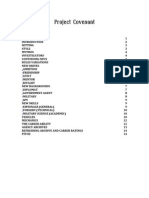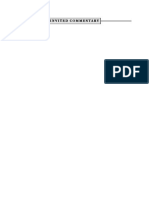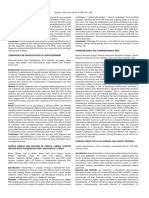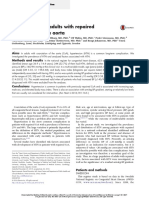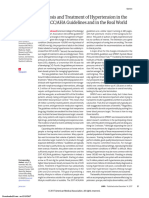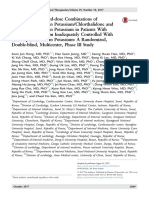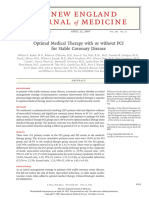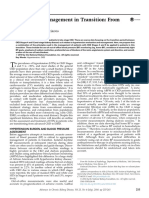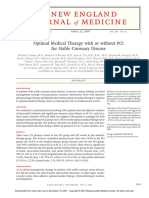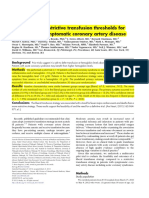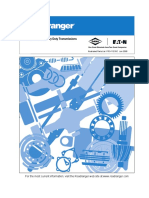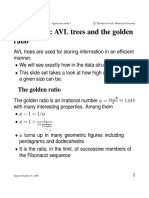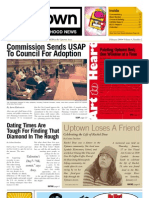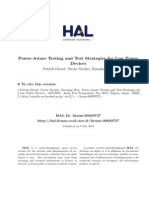FCVM 09 860322
FCVM 09 860322
Uploaded by
Muh SutraCopyright:
Available Formats
FCVM 09 860322
FCVM 09 860322
Uploaded by
Muh SutraOriginal Title
Copyright
Available Formats
Share this document
Did you find this document useful?
Is this content inappropriate?
Copyright:
Available Formats
FCVM 09 860322
FCVM 09 860322
Uploaded by
Muh SutraCopyright:
Available Formats
ORIGINAL RESEARCH
published: 25 April 2022
doi: 10.3389/fcvm.2022.860322
Cold Pressor Test in Primary
Hypertension: A Cross-Sectional
Study
Yue Han † , Jun Du † , Jing Wang, Bin Liu, Yu-Ling Yan, Song-Bai Deng, Ya Zou,
Xiao-Dong Jing, Jian-Lin Du, Ya-Jie Liu and Qiang She* on behalf of the CPT Study Group
Department of Cardiology, The Second Affiliated Hospital of Chongqing Medical University, Chongqing, China
Objectives: To investigate the characteristics of patients with primary hypertension who
had positive responses to the cold pressor test (CPT).
Methods: This cross-sectional study was conducted between November 2018 to
November 2019, and the CPT was performed in patients with primary hypertension in 48
hospitals. The demographic characteristics and complications were collected through
a questionnaire and physical examinations. A 12-month follow-up was conducted to
identify the occurrence of the following events: a) all-cause mortality; b) myocardial
Edited by: infarction; c) stroke; d) hospitalized for heart failure.
Lin Wei,
Soochow University, China
Results: The CPT was positive in 30.7% of the patients. Compared with the negative
Reviewed by:
CPT group, the positive CPT group was associated with a lower rate of blood pressure
Hongxing Shen, control, and was more likely to have a high salt diet, diabetes, hyperuricemia, left
Jiangsu University, China ventricular wall thickening, carotid plaques, coronary heart disease and heart failure. A
Chen Chen,
Huazhong University of Science and high-salt diet (OR = 1.228, 95%CI: 1.037–1.456) was found to be correlated with the
Technology, China positive result of CPT. Among patients in the positive CPT group, those using diuretics
*Correspondence: had a significantly higher rate of blood pressure control than those not using diuretics
Qiang She
qshe98@cqmu.edu.cn
(54.6 vs.42.6%, x² = 6.756, P = 0.009). After a 12-month follow-up, the incidence of
heart failure in the positive CPT group was significantly higher than that in the negative
† These authors have contributed
equally to this work
CPT group (7.35 vs.5.01%, x² = 3.945, P = 0.047).
Conclusions: Patients with positive responses to the CPT had lower rates of BP control
Specialty section:
and a high risk of heart failure, which may be related to their preference for a high-salt
This article was submitted to
Hypertension, diet. The use of diuretics helps to better control blood pressure in those patients.
a section of the journal
Keywords: cold pressor test, hypertension, diuretic, heart failure, prevalence
Frontiers in Cardiovascular Medicine
Received: 22 January 2022
Accepted: 22 March 2022
Published: 25 April 2022
INTRODUCTION
Citation: Hypertension is an important public health challenge worldwide and it contributes to 51% of stroke
Han Y, Du J, Wang J, Liu B, Yan Y-L, deaths and 45% of ischemic heart disease death worldwide (1–3). Studies have shown that the global
Deng S-B, Zou Y, Jing X-D, Du J-L,
prevalence of hypertension has risen continuously in recent decades, especially in low-income and
Liu Y-J and She Q (2022) Cold
Pressor Test in Primary Hypertension:
middle-income countries (4). It is estimated that 26.4% (972 million) of adults had hypertension
A Cross-Sectional Study. in 2000, and the number in 2025 is predicted to increase by about 60%, to a total of 1.56 billion
Front. Cardiovasc. Med. 9:860322. globally (3). And hypertension is also one of the most important cardiovascular diseases in China.
doi: 10.3389/fcvm.2022.860322 A national study during 2014–2017 showed that 44.7% of Chinese adults aged 35–75 years had
Frontiers in Cardiovascular Medicine | www.frontiersin.org 1 April 2022 | Volume 9 | Article 860322
Han et al. Cold Pressor Test in Hypertension
hypertension (5). And there is a close relationship between blood A 12-month follow-up was conducted to identify the
pressure level and the risk of cardiovascular and cerebrovascular occurrence of the following events: a) all-cause mortality; b)
diseases such as stroke, atrial fibrillation, and especially heart myocardial infarction; c) stroke; d) hospitalized for heart failure
failure. Hypertension leads to heart failure with preserved (The study workflow is shown in Figure 1).
ejection fraction or heart failure with reduced ejection fraction The sample size for this study was estimated based on a
in patients with coronary heart disease or myocardial infarction. previous study which found that the positive rate of CPT in
Previous data of Chinese showed that cardiovascular and normotensive was32.8% (18). PASS 15.0 was used to calculate
cerebrovascular diseases account for more than 40% of all the sample size. A sample size of 1403 produces a two-sided 95%
deaths (6). However, the management of hypertension remains confidence interval with a width equal to 0.050 when the sample
suboptimal in China, with a low treatment rate and control rate. proportion is 33%.
Studies from 1997 to 2017 shows that the ranges of hypertension
prevalence, awareness, treatment, and control rate among Inclusion/Exclusion Criteria
hypertensive patients were 18.0–44.7, 23.6–56.2, 14.2–48.5, and The CPT was performed in patients with primary hypertension
4.2–30.1% respectively (7). Thus, it is important to improve the in 48 hospitals from November 2018 to November 2019.
control rate of hypertension and prevent complications. Patients were included based on the following inclusion
The cold pressor test (CPT), which was developed by a criteria: age above 18 years and a diagnosis of primary
physician in the division of medicine at the Mayo Clinic hypertension (systolic BP ≥ 140 mmHg and/or diastolic BP ≥
Rochester, Edgar A. Hines, Jr. (1906–1978) (8), has been used 90 mmHg on at least three occasions on different days).
as a nonspecific and strong stimulus to sympathetic neural Patients were excluded on the basis of the following criteria:
outflow in humans. It evokes remarkable increases in blood primary aldosteronism or other diseases or causes of secondary
pressure and muscle sympathetic nerve activity (MSNA) with hypertension; systolic BP (SBP) ≥ 180 mmHg and/or diastolic
no significant changes in heart rates (9, 10), and was used BP (DBP) ≥ 110 mmHg; severe heart or lung diseases, acute stage
to assess the vasoconstrictor reserve (11). The reflex pathway stroke (<3 months) or end-tage cancer; inability to undergo the
to activate MSNA may originate from cold nociceptors in the cold pressor test; or pregnancy.
skin that conduct afferent signals by unmyelinated C-fibers,
and the pathway may involve a central vasomotor center that Cold Pressor Test Protocol
serves to regulate MSNA (10, 12). Therefore, CPT was also The participants were seated, and the blood pressure of the right
be used to evaluate the sympathetic reactivity in patients with upper arm was measured three times with a calibrated electronic
orthostatic hypotension (13). For a long time, CPT was also used sphygmomanometer or standard mercury sphygmomanometer
as a tool to study BP variability. Hines and Brown performed after the patients had rested for 20 minutes in a room with
CPT in 40 healthy participants and found that the degree to appropriate temperature. The average blood pressure of the three
which blood pressure responses to cold stimuli can be divided measurements was taken as the basic blood pressure. Then, the
into three categories: a minimal increase of blood pressure in participants immersed their left hands in ice water at 3–5◦ C for 1
healthy participants, a much higher increase of blood pressure minute. The blood pressure of the right upper arm was measured
in hypertension, and a similar reaction to the patients with 0 min, 1 min, 2 min, and 4 min after removal of the left hand from
hypertension in those participants who were recognized at high the ice water. The test was considered positive if the SBP, DBP or
risk for developing hypertension. Thus, CPT was thought to mean arterial pressure (MAP) increased ≥ 15 mmHg after cold
predict a subject’s risk of developing hypertension. Subsequent stimulation. The test was considered negative if the SBP, DBP or
studies have also shown that response to CPT in individuals mean arterial pressure (MAP) increased < 15 mmHg after cold
healthy can predict hypertension (14–17). However, it is not clear stimulation. MAP = (SBP + 2 × DPB)/3 or MAP = DBP +
whether CPT can also predict cardiovascular risk and how is the 1/3 (SBP-DBP).
prevalence of positive CPT in patients with hypertension. Our This study was approved by the ethical committee of
study performed CPT in a large number of patients with primary Chongqing Medical University, and written informed consent
hypertension for the first time, aim to determine the prevalence was obtained from all patients participating in the study.
of the positive CPT in patients with primary hypertension, and
to investigate the characteristics and the risk of cardiovascular Standard for Blood Pressure Under Control
events of those patients. The standard was based on the Guidelines for the prevention
and treatment of hypertension in China (revised in 2018) (6).
MATERIALS AND METHODS The target BP is < 140/90 mmHg for the general population,
< 150/90 mmHg for those older than65 years,< 140/90 mmHg
Study Design and Sample Size Estimation for those with coronary heart disease or kidney disease (without
This was an observational, cross-sectional study. Data from proteinuria), and < 130/80 mmHg for those with diabetes
the enrolled patients were collected during the first interview mellitus, heart failure or kidney disease (with proteinuria).
and then entered into a database, including their medical
and pharmacological histories. The CPT and a physical Statistical Analysis
examination, including measurement of height, weight, and BP All data were input by two independent researchers using
were conducted during the first interview. EpiData V.3.1 (EpiData Association, Odense, Denmark), and
Frontiers in Cardiovascular Medicine | www.frontiersin.org 2 April 2022 | Volume 9 | Article 860322
Han et al. Cold Pressor Test in Hypertension
FIGURE 1 | Study workflow.
the database was established after checking for differences in (2865 patients); in the rest of the patients, it could not be
the two records. SPSS Statistics version 21.0 (IBM, Armonk, performed due to cold intolerance (8.5%).
New York) was used for statistical analysis. Categorical variables A total of 880 patients (30.7%) screened positive with the CPT
were analyzed with χ2 tests. The factors influencing CPT and were placed in the positive group, and the other 1985 were
were screened and determined by multivariable binary logistic placed in the negative group.
regression analysis. Statistical significance was defined as a p-
value < 0.05.
Characteristics of Participants
The baseline data and complications for the included patients
RESULTS are shown in Table 1. The proportion of patients with a high
salt diet, diabetes, hyperuricemia, left ventricular wall thickening,
Cold Pressor Test Results carotid plaques, coronary heart disease and heart failure were
From November 2018 to November 2019, 3132 patients with much greater in the positive group than the negative group (P
primary hypertension in 48 hospitals were invited to participate < 0.05). However, there were no significant differences in the
in our study. The CPT was performed in 91.5% of the population proportion of sex, age, BMI, family history of hypertension,
Frontiers in Cardiovascular Medicine | www.frontiersin.org 3 April 2022 | Volume 9 | Article 860322
Han et al. Cold Pressor Test in Hypertension
TABLE 1 | Clinical characteristics of the participants.
Characteristics Total Positive group Negative group x² P-value
(n/N) N (%) N (%)
Baseline
Sex (male, %) 1303/2865 401 (45.6) 902 (45.4) 0.004 0.950
Age ≥ 65 years 1260/2865 397 (45.1) 863 (43.5) 0.664 0.415
Body mass index (BMI) ≥ 24 kg/m2 1607/2830 508 (58.7) 1099 (56.0) 1.790 0.181
Family history of hypertension 1179/2825 372 (43.2) 807 (41.1) 1.030 0.310
Current smoker 641/2865 203 (23.1) 438 (22.1) 0.353 0.552
Current drinker 579/2865 177 (20.1) 402 (20.3) 0.007 0.932
High salt diet 1496/2865 500 (56.8) 996 (50.2) 10.780 0.001
Hyperlipidemia 1015/2782 328 (38.5) 687 (35.6) 2.148 0.143
Diabetes 512/2818 179 (20.6) 333 (17.1) 4.812 0.028
Hyperuricemia 317/2700 116 (13.9) 201 (10.8) 5.625 0.018
Complications
Left ventricular wall thickening 326/2649 129 (15.8) 197 (10.8) 13.033 0.000
Carotid plaques 404/2574 162 (20.5) 242 (13.6) 19.938 0.000
Higher values of serum creatinine or proteinuria 155/2620 52 (6.4) 103 (5.7) 0.567 0.452
Coronary heart disease 465/2740 168 (19.9) 297 (15.7) 7.454 0.006
Heart failure 92/2722 38 (4.5) 54 (2.9) 4.906 0.027
Body mass index (BMI) referred to weight in kilograms (kg) divided by height in meters squared (m2). Current smoker referred to smoking at least 1 cigarette every day. Current drinker
referred to drinking alcohol at least 1 time/month in the previous 1 year. A high salt diet referred to the intake of at least 6g of salt every day. Hyperlipidemia referred to either TG ≥ 2.26
mmol/L, TC ≥ 5.2 mmol/L, LDL-C ≥ 3.4 mmol/L or self-reported use of lipid-lowering drugs. Diabetes referred to the use of hypoglycemic medication or a measured fasting blood
glucose level ≥ 7.0 mmol/L or non-fasting blood glucose level ≥ 11.1 mmol/L. Hyperuricemia referred to blood uric acid > 420umol/L or 7mg/dL in two tests on different days.
5.335, P = 0.021). In the positive CPT group, most patients took
TABLE 2 | Analysis of factors associated with positive results of CPT.
renin-angiotensin-aldosterone system (RAAS) inhibitors (60.5%)
B S.E. P-value OR (95%CI) to control blood pressure, followed by calcium channel blockers
(CCB, 58.9%), diuretics (16%), and beta-blockers (12.5%). The
Sex 0.031 0.097 0.748 1.032 (0.853–1.249) comparison of the blood pressure control rates among four
Age 0.125 0.088 0.156 1.133 (0.953–1.346) antihypertensive therapies is shown in Figure 2. The blood
BMI 0.086 0.088 0.329 1.089 (0.918–1.293) pressure control rate for patients using diuretics was significantly
Family history of 0.078 0.088 0.374 1.082 (0.910–1.285) higher than that for patients who did not use diuretics (54.6
hypertension
vs.42.6%, x² = 6.756, P = 0.009). However, there was no
High salt diet 0.206 0.087 0.018 1.228 (1.037–1.456) significant difference in whether CCB, beta-blockers, or RAAS
Current drinker 0.077 0.123 0.528 1.080 (0.850–1.374) inhibitors were used.
Hyperlipidemia 0.047 0.273 0.601 1.049 (0.878–1.253) 1,862 patients were followed up for 12-month to determine
Diabetes 0.186 2.952 0.086 1.205 (0.974–1.490) the incidence of adverse events. There was no significant
Hyperuricemia 0.238 3.351 0.067 1.269 (0.983–1.637) difference in all-cause mortality, myocardial infarction, or stroke
between the positive group and the negative group, but the
hospitalization due to heart failure in the positive CPT group
was significantly higher than that in the negative CPT group
smoking, drinking, hyperlipidemia, or higher values of serum (Table 3).
creatinine or proteinuria between the two groups (p > 0.05). A
high-salt diet (OR = 1.228, 95%CI: 1.037–1.456) was found to be
correlated with the positive result of CPT (Table 2).
DISCUSSION
Medication and Adverse Events of CPT, which has long been a standard test for sympathetic
Participants function, has been documented to predict the subsequent risk
Among the 2865 patients included in this study, 2375 patients of hypertension in normotensive persons (14–17). However, the
regularly took antihypertensive drugs, including 766 (87.0%) in physiological basis of the BP responses to the CPT is not yet
the positive CPT group and 1609 (81.1%) in the negative CPT fully understood. Studies have shown that the reason for CPT
group. Among the patients regularly taking antihypertensive increasing BP may be the significant constriction of arterioles
drugs, the blood pressure compliance rate was significantly lower by inducing systemic or local sympathetic nerve activation
in the positive group than the negative group (44.8 vs.49.8%, x² = (9, 19–22), and CPT can increase plasma norepinephrine
Frontiers in Cardiovascular Medicine | www.frontiersin.org 4 April 2022 | Volume 9 | Article 860322
Han et al. Cold Pressor Test in Hypertension
FIGURE 2 | Comparison of blood pressure control rates among different medication. RAAS, renin-angiotensin-aldosterone system; CCB, calcium channel blockers.
(19, 21) and myosympathetic nerve activity (9, 20, 22). TABLE 3 | Incidence of adverse events.
The stimulus itself is also complex and dynamic, and may
Adverse events Positive Negative P-value
cause pain and distress, which, in turn, can contribute to group group
sympathetic activation. (N = 544) (N = 1318)
Keller-Ross et al. conducted a study showing an age-and (n, %) (n, %)
sex-dependent increase in muscle sympathetic nerve activity
incidence and frequency with the CPT (23), which contributed to All-cause mortality 2 (0.37) 2 (0.15) 0.36
greater support of BP during the CPT in the older women. While, Myocardial infarction 0 (0.00) 2 (0.15) 0.363
our study shows that in hypertensive patients, the BP responses Stroke 4 (0.74) 8 (0.61) 0.753
to the CPT were independent of gender and age, and the patients Hospitalized for heart failure 40 (7.35) 66 (5.01) 0.047
with diabetes, carotid artery plaque, and coronary heart disease
in the positive CPT group were significantly higher than those in
the negative group. This may be related to vascular endothelial
dysfunction in these patients. Studies have shown that healthy were more easily observed in the CPT positive group in
endothelial cells maintain low levels of oxidative stress and relax our study.
vascular tension by releasing vascular active mediators such as Previous studies showed that BP responses to CPT vary from
nitric oxide, prostacyclin I2 (PGI2), bradykinin, endothelin-1 individual to individual in healthy people, and our study showed
(ET-1), and angiotensin II (Ang-II) (24–29). Imbalance of these that in the population with primary hypertension, different
factors can lead to endothelial dysfunction, which ultimately individuals still had different responses to CPT, and the high
leads to cardiovascular complications such as arterial plaque and response rate of CPT was 30.7%. We found that patients with
coronary heart disease (30, 31). Nabel et al. (32) showed that CPT responsiveness were characterized by a high-salt diet. Jing
normal arteries dilated and diseased arteries contracted after Chen et al. (33) showed that BP response to the CPT was
CPT. In normal blood vessels, CPT may induce coronary dilation associated with salt sensitivity and potassiumsensitivity. And a
by acting on β 2-adrenergic receptors on coronary vascular low-sodium or high-potassium diet might be more effective to
smooth muscle cells via catecholamines and by stimulating α 2- lower BP among individuals with high responses to the CPT,
adrenergic receptors on coronary endothelial cells to stimulate while a high sodium diet could increase systolic blood pressure
nitric oxide synthesis. Vasoconstriction was observed in patients in patients with positive results of CPT. These results indicate
with cardiovascular disease, such as coronary heart disease. This that high responses to the CPT may be related to salt sensitivity
may also be the reason why coronary heart disease complications of BP.
Frontiers in Cardiovascular Medicine | www.frontiersin.org 5 April 2022 | Volume 9 | Article 860322
Han et al. Cold Pressor Test in Hypertension
Previous studies have also suggested that sympathetic ETHICS STATEMENT
nervous system activity might play an important role in
determining the salt-sensitivity of BP (34), which affects renal The studies involving human participants were reviewed and
hemodynamics, sodium and water processing (35, 36). Salt- approved by the Ethical Committee of Chongqing Medical
sensitive hypertension is characterized by a high blood pressure University. The patients/participants provided their written
response to sodium intake, which is often manifested by informed consent to participate in this study.
abnormal sodium metabolism, renal sodium retention, and
enhanced sympathetic nerve activity. These pathophysiological AUTHOR CONTRIBUTIONS
features further lead to the retention of water and sodium.
Diuretics help the kidneys get rid of excess water and sodium. YH: methodology, performing the experiments, data curation,
Therefore, diuretics have an obvious antihypertensive effect on formal analysis, writing—original draft preparation, and
salt-sensitive hypertension. Our study found that patients with writing—review and editing. JD: methodology, performing the
high responses to CPT and patients with salt sensitivity had experiments, data curation, and formal analysis. JW: performing
similar characteristics, and the use of diuretics improve the the experiments, and data curation. BL: writing—review and
control rate of BP in the positive group of CPT, which also editing. S-BD: validation. Y-LY: writing—review and editing.
suggested that patients with high responses to CPT may also YZ: performing the experiments. X-DJ: data curation. J-LD:
have salt sensitivity of BP. And we also found that the incidence writing—review and editing. Y-JL: data curation. CPT Study
of heart failure was significantly higher in the positive group Group: performing the experiments. QS: supervision, project
than in the negative group of CPT. We thought that may be administration, and writing—review and editing. All authors
related to the higher incidence of water and sodium retention contributed to the article and approved the submitted version.
in the positive group. These findings also support that patients
with high responses to CPT have similar characteristics to FUNDING
patients with salt-sensitive hypertension. Therefore, CPT may
become a new diagnostic method for salt-sensitive hypertension. This work was supported by grants from the foundation
However, there are still few studies on the application of CPT for innovative Research Groups of National Natural Science
in the diagnosis of salt-sensitive hypertension, and we need Foundation of China (81770251) and Chongqing Science and
more studies to compare CPT and acute venous saline load or Technology Foundation (cstc2017shmsA130086).
chronic dietary salt load test to understand the role of CPT in the
diagnosis of salt-sensitive hypertension. ACKNOWLEDGMENTS
CONCLUSIONS The authors thank the other members of the CPT study group
from 48 hospitals in Chongqing: Sha-Sha Zeng, Ping Li, Xian-
Patients with high responses to CPT had lower rates of BP control Hu Luo, Jian-Jun Wu, Hong-Bin Yu, Li-Qun Ran, Ting-Rong
and a high risk of heart failure, which may be related to their Liu, Hong Lu, Yan Lin, Chun Yang, You-Gui Gong, Shi-Quan
preference for a high-salt diet. The use of diuretics helps to better Fu, Heng-Hua Dai, Guo-Fu Li, Qing Zhang, Yuan-You Chen,
control blood pressure in primary hypertensive patients with Qiang Li, Fa-Qiong Liu, Feng Yan, Hao Wang, Shi-Cai Lan, Qing-
positive results of CPT. Bin Liao, Xin-Hua Yang, Zhong-Lin Xu, Ren-Hai Liu, Xun Liu,
Jin-Wu Xu, Yong-Yue Tian, Ze-Hui Ao, Xiao-Ke Wang, Zhen-
DATA AVAILABILITY STATEMENT Yun Wu, Liang-Yi Si, Hong-Jun Liu, Chun-Lin Xiong, Qian-Shu
Zhang, Jie Chen, Ming-Cheng Li, Xiao-Hua Pang, Chang-Qing
The raw data supporting the conclusions of this Yu, Hong-Dong Xia, Lian Zeng, Chuan He, Dong Ma, Mei Yang,
article will be made available by the authors, without Chao-Jiang Zhu, Lu-Xiang Chi, Ya-Li Hong, Hong Huang, Yi
undue reservation. Wang, Hui-Ping Yang, Bing-Quan Xiong, Jing Chen.
REFERENCES 4. GBD 2016 Risk Factors Collaborators. Global, regional, and national
comparative risk assessment of 84 behavioural, environmental and
1. Kearney PM, Whelton M, Reynolds K, Muntner P, Whelton PK, He J. occupational, and metabolic risks or clusters of risks, 1990–2016: a
Global burden of hypertension: analysis of worldwide data. Lancet. (2005) systematic analysis for the global burden of disease study 2016. Lancet.
365:217–23. doi: 10.1016/S0140-6736(05)17741-1 2017. 390:1345–422. doi: 10.1016/S0140-6736(17)32366-8
2. He J, Whelton PK. Salt intake, hypertension and risk of cardiovascular disease: 5. Lu J, Lu Y, Wang X, Li X, Linderman GC, Wu C. Prevalence, awareness,
an important public health challenge. Int J Epidemiol. 2002. 31(2):327–31. treatment, and control of hypertension in China: data from 1·7 million
doi: 10.1093/ije/31.2.327 adults in a population-based screening study (China PEACE million persons
3. Lim SS, Vos T, Flaxman AD, Danaei G, Shibuya PK, Adair-Rohani H, et al. project). Lancet. (2017) 390:2549–58. doi: 10.1016/S0140-6736(17)32478-9
A comparative risk assessment of burden of disease and injury attributable to 6. Joint Committee for Guideline Revision. 2018 Chinese Guidelines for
67 risk factors and risk factor clusters in 21 regions, 1990-2010: a systematic prevention and treatment of hypertension-a report of the revision committee
analysis for the global burden of disease study 2010. Lancet. (2012) 380:2224– of chinese guidelines for prevention and treatment of hypertension. J Geriatr
60. doi: 10.1016/S0140-6736(12)61766-8 Cardiol. (2019) 16:182–241. doi: 10.11909/j.issn.1671-5411.2019.03.014
Frontiers in Cardiovascular Medicine | www.frontiersin.org 6 April 2022 | Volume 9 | Article 860322
Han et al. Cold Pressor Test in Hypertension
7. Yin R, Yin L, Li L, Silva-Nash J, Tan J, Pan Z, et al. Hypertension in China: 25. Just A, Whitten CL, Arendshorst WJ. Reactive oxygen species participate in
burdens, guidelines and policy responses: a state-of-the-art review. J Hum acute renal vasoconstrictor responses induced by ETA and ETB receptors. Am
Hypertens. (2021) 36:126–34. doi: 10.1038/s41371-021-00570-z J Physiol Renal Physiol. (2008) 294:F719–28. doi: 10.1152/ajprenal.00506.2007
8. Lamotte G, Boes CJ, Low PA, Coon EA. The expanding role of the 26. Lai WK, Kan MY. Homocysteine-induced endothelial dysfunction. Ann Nutr
cold pressor test: a brief history. Clin Auton Res. (2021) 31:153–5. Metab. (2015) 67:1–12. doi: 10.1159/000437098
doi: 10.1007/s10286-021-00796-4 27. Moncada S, Gryglewski R, Bunting S, Vane JR. An enzyme isolated from
9. Victor RG, Leimbach WN Jr, Seals DR, Wallin BG, Mark AL. Effects of the cold arteries transforms prostaglandin endoperoxides to an unstable substance that
pressor test on muscle sympathetic nerve activity in humans. Hypertension. inhibits platelet aggregation. Nature. (1976) 263:663–5. doi: 10.1038/263663a0
(1987) 9:429–36. doi: 10.1161/01.HYP.9.5.429 28. Yanagisawa M, Kurihara H, Kimura S, et al. A novel potent vasoconstrictor
10. Yamamoto K, Iwase S, Mano T. Responses of muscle sympathetic nerve peptide produced by vascular endothelial cells. Nature. (1988) 332:411–5.
activity and cardiac output to the cold pressor test. Jpn J Physiol. (1992) doi: 10.1038/332411a0
42:239–52. doi: 10.2170/jjphysiol.42.239 29. Endemann DH, Schiffrin EL. Endothelial dysfunction. J Am Soc Nephrol.
11. Fu Q, Witkowski S, Levine BD. Vasoconstrictor reserve and sympathetic (2004) 15:1983–92. doi: 10.1097/01.ASN.0000132474.50966.DA
neural control of orthostasis. Circulation. (2004) 110:2931–7. 30. Green DJ, Hopman MT, Padilla J, Laughlin MH, Thijssen DH. Vascular
doi: 10.1161/01.CIR.0000146384.91715.B5 adaptation to exercise in humans: role of hemodynamic stimuli. Physiol Rev.
12. Schobel HP, Schmieder RE, Hartmann S, Schächinger H, Luft FC. Effects of (2017) 97:495–528. doi: 10.1152/physrev.00014.2016
bromocriptine on cardiovascular regulation in healthy humans. Hypertension. 31. Green DJ, Jones H, Thijssen D, Cable NT, Atkinson G. Flow-mediated dilation
(1995) 25:1075–82. doi: 10.1161/01.HYP.25.5.1075 and cardiovascular event prediction: does nitric oxide matter. Hypertension.
13. Khandelwal E, Jaryal AK, Deepak KK. Cardiovascular autonomic functions & (2011) 57:363–9. doi: 10.1161/HYPERTENSIONAHA.110.167015
cerebral autoregulation in patients with orthostatic hypotension. Indian J Med 32. Nabel EG, Ganz P, Gordon JB, Alexander RW, Selwyn AP. Dilation of normal
Res. (2011) 134:463–9. and constriction of atherosclerotic coronary arteries caused by the cold
14. Weinberger MH. The cold pressor test: a new predictor of future pressor test. Circulation. (1988) 77:43–52. doi: 10.1161/01.CIR.77.1.43
hypertension. Arch Intern Med. (2008) 168:1732. doi: 10.1001/archinte.168. 33. Chen J, Gu D, Jaquish CE, et al. Association between blood pressure
16.1732 responses to the cold pressor test and dietary sodium intervention
15. Loyke HF. Cold pressor test as a predictor of the severity of hypertension. in a Chinese population. Arch Intern Med. (2008) 168:1740–6.
South Med J. (1995) 88:300–4. doi: 10.1097/00007611-199503000-00010 doi: 10.1001/archinte.168.16.1740
16. Menkes MS, Matthews KA, Krantz DS, Lundberg U, Mead LA, Qaqish B, 34. Strazzullo P, Barbato A, Vuotto P, Galletti F. Relationships between salt
et al. Cardiovascular reactivity to the cold pressor test as a predictor of sensitivity of blood pressure and sympathetic nervous system activity:
hypertension. Hypertension. (1989) 14:524–30. doi: 10.1161/01.HYP.14.5.524 a short review of evidence. Clin Exp Hypertens. (2001) 23:25–33.
17. Wood DL, Sheps SG, Elveback LR, Schirger A. Cold pressor test as a predictor doi: 10.1081/CEH-100001194
of hypertension. Hypertension. (1984) 6:301–6. doi: 10.1161/01.HYP.6.3.301 35. Stamler R, Liu LS, Nichols R, et al. Blood pressure and life style in the People’s
18. Kasagi F, Akahoshi M, Shimaoka K. Relation between cold pressor test Republic of China: three samples in the INTERSALT study. J Hum Hypertens.
and development of hypertension based on 28-year follow-up. Hypertension. (1993) 7:429–35.
(1995) 25:71–6. doi: 10.1161/01.HYP.25.1.71 36. Wyss JM, Oparil S, Sripairojthikoon W. Neuronal control of the kidney:
19. Halter JB, Stratton JR, Pfeifer MA. Plasma catecholamines and hemodynamic contribution to hypertension. Can J Physiol Pharmacol. (1992) 70:759–70.
responses to stress states in man. Acta Physiol Scand Suppl. (1984) 527:31–8. doi: 10.1139/y92-100
20. Fagius J, Karhuvaara S, Sundlöf G. The cold pressor test: effects on
sympathetic nerve activity in human muscle and skin nerve fascicles. Conflict of Interest: The authors declare that the research was conducted in the
Acta Physiol Scand. (1989) 137:325–34. doi: 10.1111/j.1748-1716.1989.tb0 absence of any commercial or financial relationships that could be construed as a
8760.x potential conflict of interest.
21. Ward MM, Mefford IN, Parker SD, Chesney MA, Taylor CB, Keegan DL,
et al. Epinephrine and norepinephrine responses in continuously collected Publisher’s Note: All claims expressed in this article are solely those of the authors
human plasma to a series of stressors. Psychosom Med. (1983) 45:471–86. and do not necessarily represent those of their affiliated organizations, or those of
doi: 10.1097/00006842-198312000-00002
the publisher, the editors and the reviewers. Any product that may be evaluated in
22. Seals DR. Sympathetic activation during the cold pressor
this article, or claim that may be made by its manufacturer, is not guaranteed or
test: influence of stimulus area. Clin Physiol. (1990) 10:123–9.
doi: 10.1111/j.1475-097X.1990.tb00246.x endorsed by the publisher.
23. Keller-Ross ML, Cunningham HA, Carter JR. Impact of age and
sex on neural cardiovascular responsiveness to cold pressor test in Copyright © 2022 Han, Du, Wang, Liu, Yan, Deng, Zou, Jing, Du, Liu and She.
humans. Am J Physiol Regul Integr Comp Physiol. (2020) 319:R288–95. This is an open-access article distributed under the terms of the Creative Commons
doi: 10.1152/ajpregu.00045.2020 Attribution License (CC BY). The use, distribution or reproduction in other forums
24. Pouwels S, Van Genderen ME, Kreeftenberg HG, et al. Utility of is permitted, provided the original author(s) and the copyright owner(s) are credited
the cold pressor test to predict future cardiovascular events. Expert and that the original publication in this journal is cited, in accordance with accepted
Rev Cardiovasc Ther. (2019) 17:305–18. doi: 10.1080/14779072.2019.15 academic practice. No use, distribution or reproduction is permitted which does not
98262 comply with these terms.
Frontiers in Cardiovascular Medicine | www.frontiersin.org 7 April 2022 | Volume 9 | Article 860322
You might also like
- Project Covenant For Trail of CthulhuDocument14 pagesProject Covenant For Trail of CthulhuPelgranePressNo ratings yet
- A Study To Assess The Effectiveness of Hibiscus Sabdariffa On Hypertensive Patients in Rural AreaDocument6 pagesA Study To Assess The Effectiveness of Hibiscus Sabdariffa On Hypertensive Patients in Rural AreaEditor IJTSRDNo ratings yet
- Medscimonit 25 5717Document10 pagesMedscimonit 25 5717Nurfitriah NasirNo ratings yet
- 1 s2.0 S0965229915001053 Main PDFDocument8 pages1 s2.0 S0965229915001053 Main PDFAdy JimblengNo ratings yet
- Ic 00526Document2 pagesIc 00526ayepaayepa20No ratings yet
- Hypertension Control, Apparent Treatment Resistance, and Outcomes in The Elderly Population With Chronic Kidney DiseaseDocument12 pagesHypertension Control, Apparent Treatment Resistance, and Outcomes in The Elderly Population With Chronic Kidney Diseasetika_876267153No ratings yet
- Postdialysis Hypertension: Associated Factors, Patient Profiles, and Cardiovascular MortalityDocument6 pagesPostdialysis Hypertension: Associated Factors, Patient Profiles, and Cardiovascular MortalityLaura PutriNo ratings yet
- Effects of Hemodialysis With Cooled Dialysate On High Sensitivity Cardiac Troponin I and Brain Natriuretic PeptideDocument7 pagesEffects of Hemodialysis With Cooled Dialysate On High Sensitivity Cardiac Troponin I and Brain Natriuretic PeptideinstalasidialisisrsmsNo ratings yet
- Guo., 2021. Hipertensi With LVH Pada Prolong QTDocument8 pagesGuo., 2021. Hipertensi With LVH Pada Prolong QThasan andrianNo ratings yet
- Trial of Intensive Blood-Pressure Control in Older Patients With HypertensionDocument12 pagesTrial of Intensive Blood-Pressure Control in Older Patients With HypertensionlucianaNo ratings yet
- Beckett 2008Document12 pagesBeckett 2008Cifa Maurer ParinussaNo ratings yet
- Postdialysis Hypertension 2016 American G HypertensionDocument6 pagesPostdialysis Hypertension 2016 American G HypertensionOana DragneNo ratings yet
- 2359 4802 Ijcs 34 05 s01 0012.x98175Document10 pages2359 4802 Ijcs 34 05 s01 0012.x98175Suryati HusinNo ratings yet
- BPROAD Trial - Intensive BP Control for T2D (2024)Document13 pagesBPROAD Trial - Intensive BP Control for T2D (2024)maimohamedNo ratings yet
- ESCAPE Study - JAMA 2005Document9 pagesESCAPE Study - JAMA 2005MICHAEL AMARILLO CORREANo ratings yet
- Effect of coenzyme Q10 on the incidence of atrial fibrillation in patients with heart failureDocument6 pagesEffect of coenzyme Q10 on the incidence of atrial fibrillation in patients with heart failureCesar CuneoNo ratings yet
- Controlled Level and Variability of Systolic Blood Pressure On TheDocument7 pagesControlled Level and Variability of Systolic Blood Pressure On TheJeanette LuevanosNo ratings yet
- Evaluation Study of Congestive Heart Failure and Pulmonary Artery Catheterization EffectivenessDocument9 pagesEvaluation Study of Congestive Heart Failure and Pulmonary Artery Catheterization EffectivenessMelisa AnaNo ratings yet
- Exercise Stress Test As An Antidote For Anxiety Ne PDFDocument2 pagesExercise Stress Test As An Antidote For Anxiety Ne PDFmehrshad Farahpour Gp5No ratings yet
- Risk of Systolic HT in Elderly metaanalysis-EHJ 2000Document8 pagesRisk of Systolic HT in Elderly metaanalysis-EHJ 2000UwONo ratings yet
- 2 PBDocument6 pages2 PBChristel TorresNo ratings yet
- Jurnal HipertensiDocument6 pagesJurnal HipertensiSeruni Allisa AslimNo ratings yet
- Ioannidis 2017Document2 pagesIoannidis 2017Endang Dwii SuhartiningsihNo ratings yet
- 302 Cardiovascular Risk: AssessmentDocument1 page302 Cardiovascular Risk: AssessmentLêHữuHoàiNo ratings yet
- Clinical Therapeutics/Volume 39, Number 10, 2017: These Authors Contributed Equally To This WorkDocument12 pagesClinical Therapeutics/Volume 39, Number 10, 2017: These Authors Contributed Equally To This WorkskoamdaskondiajosNo ratings yet
- Webinar1 Presentation HMforNEXTDocument130 pagesWebinar1 Presentation HMforNEXTAdrian BălanNo ratings yet
- 2017-Taravatmanesh, Et Al-2017 - Determining The Factors Associated With Cardiovascular Disease Recurrence Tehran Lipid and Glucose StudyDocument7 pages2017-Taravatmanesh, Et Al-2017 - Determining The Factors Associated With Cardiovascular Disease Recurrence Tehran Lipid and Glucose Studycipto susiloNo ratings yet
- International Journal of Scientific Research: General MedicineDocument2 pagesInternational Journal of Scientific Research: General MedicineSonuNo ratings yet
- Fendo 13 1007557Document9 pagesFendo 13 1007557Isini sehansa amarathungaNo ratings yet
- Trends in Prevalence and Control of Hypertension According To The 2017 American College of Cardiology/American Heart Association (ACC/AHA) GuidelineDocument11 pagesTrends in Prevalence and Control of Hypertension According To The 2017 American College of Cardiology/American Heart Association (ACC/AHA) GuidelineDiana Alvarez SedanoNo ratings yet
- 63vol13issue1pp360-363.20240130041945Document4 pages63vol13issue1pp360-363.20240130041945Saurav DubeyNo ratings yet
- Original Journal About CKDDocument12 pagesOriginal Journal About CKDariesulaemanNo ratings yet
- New England Journal Medicine: The ofDocument14 pagesNew England Journal Medicine: The ofIMNo ratings yet
- Pulse Wave Velocity and Its Usefulness in Estimation of HypertensionDocument7 pagesPulse Wave Velocity and Its Usefulness in Estimation of HypertensionJayanthi ThiruvengadamNo ratings yet
- Hypertension Management in Transition From CKD A ERDS 2016Document7 pagesHypertension Management in Transition From CKD A ERDS 2016hemer hadyn calderon alvitesNo ratings yet
- Mechanisms, Clinical Implications, and Treatment of Intradialytic HypotensionDocument7 pagesMechanisms, Clinical Implications, and Treatment of Intradialytic Hypotensionhemer hadyn calderon alvitesNo ratings yet
- CourageDocument14 pagesCourageSuryaNo ratings yet
- ISH-Hypertension-News-July-2024_ESPRIT-trialDocument3 pagesISH-Hypertension-News-July-2024_ESPRIT-trialDhruv MishraNo ratings yet
- Comparison of Inflammatory Markers in HTNDocument6 pagesComparison of Inflammatory Markers in HTNDan JohnstonNo ratings yet
- Carson LiberalvsRestrictiveTransfusionforSymptomaticCAD AmHeartJ 2013 PDFDocument9 pagesCarson LiberalvsRestrictiveTransfusionforSymptomaticCAD AmHeartJ 2013 PDFDio AlexanderNo ratings yet
- Print 2 PDFDocument6 pagesPrint 2 PDFfk unswagatiNo ratings yet
- Materials and MethodsDocument5 pagesMaterials and Methodsike ikeNo ratings yet
- Controversies in Hypertension II: The Optimal Target Blood PressureDocument13 pagesControversies in Hypertension II: The Optimal Target Blood PressureFideoPereNo ratings yet
- Homosistein AMIDocument7 pagesHomosistein AMIMaya RustamNo ratings yet
- Back To Cardiology ArticlesDocument10 pagesBack To Cardiology ArticlesmrezasyahliNo ratings yet
- Morning Home Blood Pressure and Cardiovascular Events in A Japanese General Practice Population Over 80 Years Old: The J-HOP StudyDocument7 pagesMorning Home Blood Pressure and Cardiovascular Events in A Japanese General Practice Population Over 80 Years Old: The J-HOP StudyWidya Ibunda DdffNo ratings yet
- Prognostic Factors in Pulmonary Arterial Hypertension: Literature ReviewDocument5 pagesPrognostic Factors in Pulmonary Arterial Hypertension: Literature Reviewhuda riyambodoNo ratings yet
- Intradialytic Hypertension in End Stage Renal Disease Patient: Prevalence and Clinical CharacteristicDocument6 pagesIntradialytic Hypertension in End Stage Renal Disease Patient: Prevalence and Clinical CharacteristicAmalNo ratings yet
- Hipertrofia VD en HTADocument8 pagesHipertrofia VD en HTAgustavo reyesNo ratings yet
- Diabetes Mellitus and Non-ST Elevation Myocardial Infarction in Thai ACS RegistryDocument8 pagesDiabetes Mellitus and Non-ST Elevation Myocardial Infarction in Thai ACS RegistrySerley WulandariNo ratings yet
- Pci On Infark MyocardDocument10 pagesPci On Infark MyocardDinny Novia WNo ratings yet
- International Journal of Scientific Research: General MedicineDocument4 pagesInternational Journal of Scientific Research: General MedicineTriple ANo ratings yet
- Identification of Normal Blood Pressure in Different Age GroupDocument8 pagesIdentification of Normal Blood Pressure in Different Age GroupmadhurocksktmNo ratings yet
- 116 229 1 SMDocument6 pages116 229 1 SMsinlookerNo ratings yet
- Hypertension (HighBloodPressure) (NHLBI) PDFDocument2 pagesHypertension (HighBloodPressure) (NHLBI) PDFHarsha Jeevan Kishore KaranamNo ratings yet
- Blood Pressure and Clinical Outcomes in The International Stroke TrialDocument7 pagesBlood Pressure and Clinical Outcomes in The International Stroke TrialMif Al-HudaNo ratings yet
- Dose-Response Association Between Level of Physical Activity and Mortality in Normal, Elevated, and High Blood PressureDocument9 pagesDose-Response Association Between Level of Physical Activity and Mortality in Normal, Elevated, and High Blood PressureChristopher LeNo ratings yet
- Nikhil Thesis AbstractDocument28 pagesNikhil Thesis AbstractNikhil KalasareNo ratings yet
- Preventive Medicine: Xiaolei Xie, Tianhua He, Jian Kang, David S. Siscovick, Yan Li, José A. PagánDocument5 pagesPreventive Medicine: Xiaolei Xie, Tianhua He, Jian Kang, David S. Siscovick, Yan Li, José A. PagánDewiNo ratings yet
- DIAB10.1002@ccd.28194 4Document9 pagesDIAB10.1002@ccd.28194 4marsim92No ratings yet
- Pioneering Heart Research: 25 Landmark Cardiovascular Clinical TrialsFrom EverandPioneering Heart Research: 25 Landmark Cardiovascular Clinical TrialsNo ratings yet
- Sample Experience Letter IND PDFDocument5 pagesSample Experience Letter IND PDFpraveen139No ratings yet
- Theories of GlobalizationDocument25 pagesTheories of GlobalizationJosebeth Cairo100% (1)
- Role of Higher Education Before Independence Eng File 49Document5 pagesRole of Higher Education Before Independence Eng File 49Ishani NayakNo ratings yet
- Love One Another Watchman NeeDocument211 pagesLove One Another Watchman NeeBeverly Renae Washington100% (2)
- Thalassemia Final Seminar by Sachin DwivediDocument51 pagesThalassemia Final Seminar by Sachin DwivediSachin DwivediNo ratings yet
- OB Assignment-1Document10 pagesOB Assignment-1Redwanur RahmanNo ratings yet
- Preface Installing The Device Communication Ports Technical Specifications Dimension Drawings CertificationDocument50 pagesPreface Installing The Device Communication Ports Technical Specifications Dimension Drawings CertificationWalter Medina LopezNo ratings yet
- MD307 Syllabus 2011Document57 pagesMD307 Syllabus 2011skyline8No ratings yet
- Deteksi Dini Masalah Psikologis Dan Perilaku Siswa Sekolah Dasar Pada Masa Pandemi Covid-19 Menggunakan Strength and Difficulties Questionnaire (SDQ)Document5 pagesDeteksi Dini Masalah Psikologis Dan Perilaku Siswa Sekolah Dasar Pada Masa Pandemi Covid-19 Menggunakan Strength and Difficulties Questionnaire (SDQ)A BNo ratings yet
- Caja 7600 Fro-11210cDocument34 pagesCaja 7600 Fro-11210cGUSTAVONo ratings yet
- Public Relation Needs & ImportanceDocument14 pagesPublic Relation Needs & Importancek123s83% (6)
- Post Test Chapter 9Document3 pagesPost Test Chapter 9Liana Febrianti100% (1)
- The Triamines Cobalt (II1) - I. Geometrical Isomers: of ofDocument7 pagesThe Triamines Cobalt (II1) - I. Geometrical Isomers: of ofDanna MartinNo ratings yet
- Gary Lane RIPDocument2 pagesGary Lane RIPrh2705No ratings yet
- Coordinated School Health Programs - LESSON 1Document4 pagesCoordinated School Health Programs - LESSON 1Jamaica DumasNo ratings yet
- WINSEM2019-20 STS2102 SS VL2019205000251 Reference Material I 14-Jan-2020 SyllogismDocument43 pagesWINSEM2019-20 STS2102 SS VL2019205000251 Reference Material I 14-Jan-2020 SyllogismAwo MohamedNo ratings yet
- Motivation Letter: Unesco-Ihe inDocument1 pageMotivation Letter: Unesco-Ihe inirmaNo ratings yet
- Sensitivity and SpecificityDocument12 pagesSensitivity and Specificitymia farrowNo ratings yet
- UntitledDocument16 pagesUntitledelle elleNo ratings yet
- Application: AVL Trees and The Golden RatioDocument11 pagesApplication: AVL Trees and The Golden RatioSureshSawantNo ratings yet
- Mathematics 1Document11 pagesMathematics 1Marose Villanueva de Guzman100% (6)
- Ria 1Document3 pagesRia 1EMEKA IKECHUKWUNo ratings yet
- February 2008 Uptown Neighborhood NewsDocument16 pagesFebruary 2008 Uptown Neighborhood NewsUptownNewsNo ratings yet
- Rule 51 Case DigestDocument2 pagesRule 51 Case DigestRochelle GablinesNo ratings yet
- Lesson Plan in Science 3 FinalDocument2 pagesLesson Plan in Science 3 Finalledesma.shaineisabelNo ratings yet
- All India Hospital ListDocument379 pagesAll India Hospital ListVed prakash Singh0% (1)
- Philippine Collegian Tomo 90 Issue 20Document12 pagesPhilippine Collegian Tomo 90 Issue 20Philippine CollegianNo ratings yet
- Power Aware Testing Strategies (Slides) PDFDocument55 pagesPower Aware Testing Strategies (Slides) PDFlim_mgNo ratings yet
- Clinical InterviewDocument14 pagesClinical InterviewsodumsuvidhaNo ratings yet
